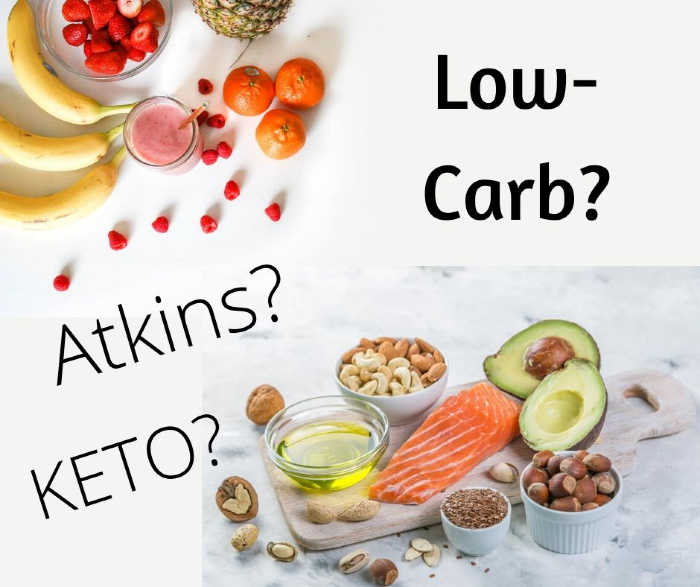3 Things To Know Before Starting a Low-Carb Diet
 Want to loose a few pounds? One way people are tackling that challenge is to switch to a low-carb diet. But before jumping in, there are a few things you should know…
Want to loose a few pounds? One way people are tackling that challenge is to switch to a low-carb diet. But before jumping in, there are a few things you should know…
1) Know your current carb intake.
2) Research foods and types of carbs.
3) Decide which low-carb plan is best for you.
Know Your Current Carb Intake
If you’re considering embarking on a low carb diet, it’s important to first know what your current carb intake is.
- Start by tracking your current carb/calorie intake
- Use an app or digital calorie tracking system that includes macronutrient information like My Fitness Pal or MyNet diary
Most American adults consume around 200 grams of carbs a day. Most low carb plans limit your initial carb intake to under 50 grams per day. So know where you’re starting at so you’ll have a good idea of the degree of change this will take.
Research Foods and Types of Carbs
- Read nutrition labels
- Research foods like vegetables and fruit. Don’t assume carbs are only in breads and pasta.
Decide Which Low-Carb Plan is Best For You
The most popular low-carb plans are Atkins and Keto. It’s important to know the differences so you can choose the one designed to give you the most success.
The Atkins Diet
Atkins is a low-carb, medium protein, high-fat diet. Atkins has several variations, but the Atkins 20 is their most popular plan.
Simply put, it has 4 phases:
- Phase 1 – Limits your carb intake to 20-25 grams of net carbs per day. Once you’re 15 lbs. away from your goal weight, then you move on to the next phase.
- Phase 2 – Consume between 25-50 grams of net carbs per day. Once you are 10 lbs. away from your goal weight, then move on to phase three.
- Phase 3 – Your carb intake is increased to 50-80 grams per day. Once you hit your goal weight, (and maintain it) you stay at this level for a month.
- Phase 4 – During this final phase, you continue to consume 80-100 grams of net carbs per day. This is important to maintain your weight loss and for ongoing weight maintenance.
The Keto Diet
Low-carb, moderate protein, high-fat diet
The goal of the Keto Diet is to get your body into a Ketosis state. This means that your body will burn fat for energy rather than drawing on sugar (from the missing carbs).
With the Keto plan, participants limit their carb intake to 20-50 grams of net carbs per day. Some people can enter a “ketosis state” at 50 net carbs, and some need to reduce that to 20-25. This will depend on your physical activity and your body make-up. There are tests you can do (breath, urine or blood tests) to see if you are in a ketosis state.
You stay at your “ketosis state” throughout the plan.
Similarities:
Atkins is like Keto in that during phase 1, you are essentially putting your body into a ketosis state. But, with Atkins, you gradually increase your carb intake over time. This allows for more variety of foods and likely more long-term success.
Alternatively, many report more rapid weight loss with Keto as you are staying in a Ketosis state throughout.
Things to watch out for:
- Restricting carbs may lead to nutrient deficiencies. Regularly eating a plate of bacon is high in fat and no carbs. This follows the keto guidelines, but it’s not the healthiest choice. Be careful to maintain healthy choices in your low-carb snacks and meals.
- Low carb diets affect your blood sugar levels. Low sugar may cause: nervousness or anxiety, chills, irritability, blurred vision or lack of coordination. If you experience any of these, have a carb-rich snack, which should alleviate the symptoms.
- Beginning Keto can cause you to experience what they call the keto flu. The keto flu is a group of symptoms you might experience during the first week of starting a ketogenic diet. Symptoms may be headache, foggy brain, fatigue, irritability, nausea, difficulty sleeping, and constipation. They’ll likely subside within a day or two. It’s important to stay hydrated and be aware of the symptoms.
People choose low carb programs as a way of life and swear by them. Others chose them temporarily to achieve weight loss goals. But like most things, your success will depend on the research and planning you do before jumping in.
If you’re interested in learning more about Atkins or Keto read more by clicking on the links below:
To read the beginners guide to the Keto diet, click here>>
For tips on how to start Atkins, click here>>